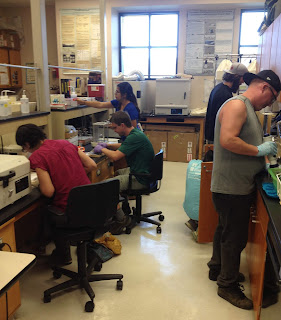In a desert ecosystem, though, the bacteria and fungi that decompose plants might have a hard time doing their job. When it is hot and dry, microbes might not be active enough to decompose the plant litter. Then how do plants get recycled in the desert when it's too hot and dry for the microbes?
Another way plant litter can be broken down is by the sun. UV radiation from the sun can break apart the molecules inside the plant. (Anyone who lives here in the Sonoran Desert knows how fast our sun's rays can break down anything we leave out in the yard!) This process is called "photodegradation". Photodegradation of plant litter can happen at the same time as soil microbes are breaking down plant litter, as long as there's sunlight. In a desert, though, sometimes photodegradation can be more important than the biological decomposition by microbes, just given how tough it is for the microbes to survive and how much sunlight we have!
Many scientists have studied the recycling that happens during decomposition by microbes. We know a lot about how nutrients get released into the soil when plant decomposes, especially in places that are cooler and wetter than the Sonoran Desert. We don't know nearly as much about nutrients getting recycled during photodegradation. The biological processes by microbes work differently than the sun to degrade plant litter. We wanted to know if that meant that nutrients are recycled differently when plant litter is being broken down by microbes or the sun.
How did we answer that question? Well, we took plant litter from one species of plant native to the Sonoran Desert. We chose triangle leaf bursage (Ambrosia deltoidea).
 |
| Max collecting litter from bursage plants |
Small holes in the plastic allowed soil microbes to invade and biologically decompose the litter when it was able to be active. We put the pouches on the ground to decompose for almost an entire year, and every few months we collected some of the bags to measure the decomposition happening inside the bags.
 |
| Bursage litter in their UV pouches in the Sonoran Desert |
 |
| Measuring mass loss and nutrient chemistry on plant litter samples in the lab |
To answer that second question, we added another experimental treatment. In the pouches that allowed UV radiation, half of the plant litter was collected from plants that were fertilized while they were growing. We also filled half of the pouches that blocked UV radiation with fertilized litter. The remaining half was filled with natural litter that wasn't fertilized. We also did the experiment in two different places at the same time: Inside the city where air pollution is happening, and outside the city where there's less air pollution.
 |
| Bursage litter in their UV pouches in the city of Phoenix. |
We also learned that plant litter grown and decomposed inside the city (where there is more nitrogen pollution in the soil) recycles nitrogen and phosphorus more quickly than litter outside the city.
Why does this matter? It tells us that one of the consequences of the air pollution in Phoenix, which is a rapidly urbanizing area of the Sonoran Desert, is that the way nutrients are recycled during decomposition can change, and that the UV radiation that is so abundant in the desert will play a big part in how it changes. That is important if you are a new plant trying to survive in the Sonoran Desert, because you rely on those recycled nutrients!
The results of this study are published in: Ball, B.A., M. Christman, S.J. Hall. 2019. Nutrient dynamics during photodegradation of plant litter in the Sonoran Desert. Journal of Arid Environments 160: 1-10. DOI:10.1016/j.jaridenv.2018.09.004




















